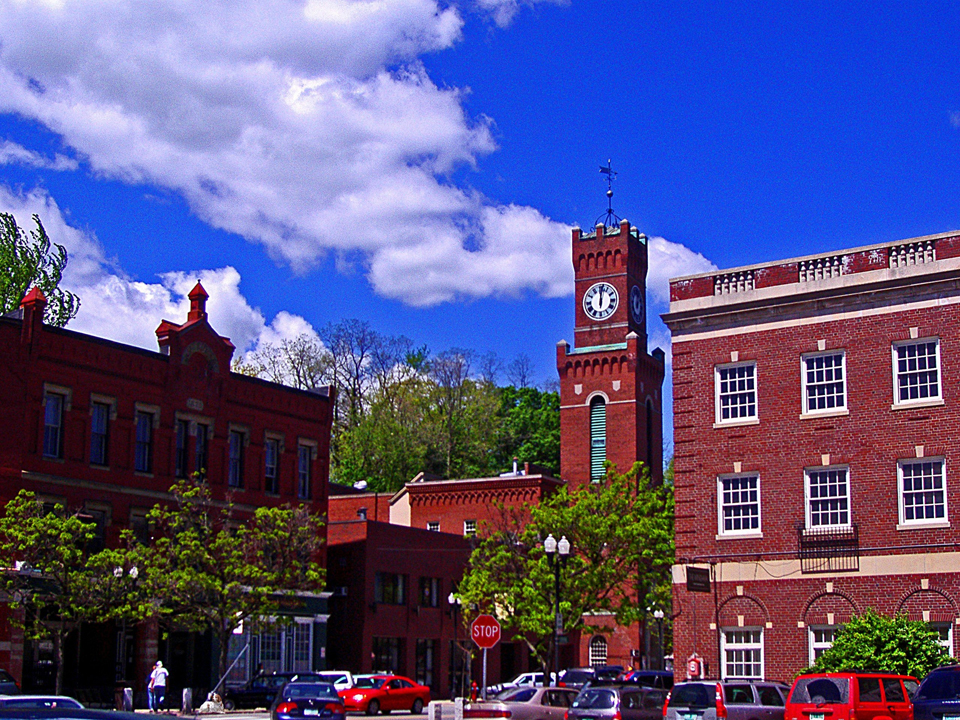Community overview
Bellows Falls has been a hub for southeastern Vermont and neighboring portions of New Hampshire for well over two centuries. In years past, its regional leadership was based on manufacturing that grew up in the mid-1900s along the canal around the nearby falls on the Connecticut River. Several decades later, railroads replaced rivers and canals as the primary mode of transportation, but Bellows Falls remained a major hub thanks to the narrow gorge at the falls, which made it the best place to build a railroad bridge across the river. Today, though, Bellows Falls is more a cultural hub than an industrial one. Community leaders in this village of 3,500 residents were among the first in Vermont to recognize the value of taking advantage of state incentives for downtown revitalization, and over the last decade or so, they have brought the village out of a period of decline by repositioning it as a vibrant community that can attract twenty-first century high-tech industries looking for great places to relocate.
Tools you can use
Like many Vermont communities, Bellows Falls struggled in the 1970s and 1980s as factories closed and residential and commercial development left the village for the outskirts. The village began to show signs of decline, with empty storefronts and deteriorating buildings. The community was not about to let its downtown die, though, and in the 1990s a number of residents began working together on a range of projects focused on restoring and enhancing the vitality of Bellows Falls’ historic center.
As a central element of their strategy, community leaders decided to apply for designation under the state Downtown Program. The community was initially attracted to the program for the state tax credits that eligible properties receive, including a 50% credit for retrofits required to bring old buildings up to current fire and safety codes and for facade improvements. The application process took several months of meetings to assemble the required materials and prepare the application. Central to the process was the Bellows Falls Downtown Development Association (BFFDA), which was formalized as an organization in response to one of the requirements of the Downtown Program, and which subsequently served as an incubator for relationships that were critical to the success of a wide range of projects that followed. For example, when the village appropriated funds for landscaping improvements at the entrance to the village, it first approached BFFDA and the Rockingham Arts and Museum Project (RAMP) about collaborating on the project. The result has been an ongoing discussion about the possibility of installing sculptures at the village gateway made out of parts from antique paper manufacturing equipment from an old Bellows Falls factory.

Downtown designation has opened up opportunities for large-scale projects as well. At the time its downtown designation was approved, the community had already been working for several years to assemble both the funding and the partners necessary to restore a row of downtown buildings known as the Exner Block. Incentives that came with designation were a key piece of the $1.5 million project, which ultimately came together as a unique partnership between Bellows Falls, Housing Vermont, and RAMP that led to the creation of 10 affordable housing units for artists as well as 6 ground-floor retail spaces. With this success in mind, BFDDA then took the lead on redevelopment of the Howard Block, another major downtown anchor, creating another 13 affordable housing units and 4 to 6 flexible storefront retail spaces.
In addition to financial incentives, the Downtown Program sponsors quarterly meetings of all Vermont’s downtown association managers. These meetings provided Bellows Falls leaders with an ongoing source of encouragement, feedback, and new ideas, which were just as important as funding to the success of many of the projects they took on. Being able to discuss issues like how to construct an effective survey, how to make most efficient use of policing resources, and other concerns common to many Vermont downtowns has helped Bellows Falls move quickly towards solutions to the challenges its downtown faces.
Lessons Learned
- Build a strong downtown association and take the time to nurture relationships across a wide range of downtown stakeholders, including local government, business owners, and nonprofits
- Look for opportunities for creative partnerships among organizations whose shared interest in a strong downtown might not be immediately obvious, such as arts organizations and affordable housing organizations
- Take full advantage not only of the financial incentives available to designated downtowns, but also of the opportunities to network with and learn from designated downtowns across Vermont
Related Issues
Related Tools




